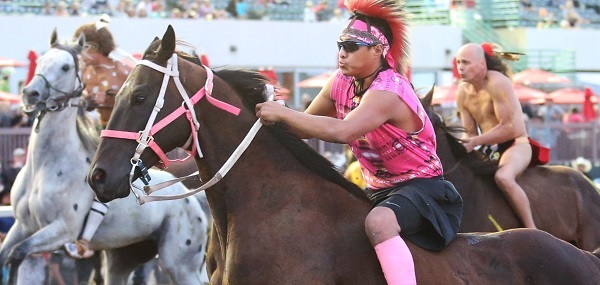BY JIM WELLS
They came from Idaho, Montana, South Dakota, North Dakota and even northern Minnesota Thursday night _ the Crow, the Lakota, Ojibwe, the Blackfeet and the Shoban.
Indian relay racing, Canterbury’s summer spectacle, returned for a third consecutive year bearing the colors, pageantry and cultural traits that these tribes bring to this form of racing.
Painted bodies and painted horses, sent onto the track with a song of prayer from traditional singers, in this particular case from members of the Dakota tribe at Mystic Lake.
Indian relay racing has become one of the track’s best promotions of the summer since it was first introduced, drawing crowds that might otherwise not attend the races. The relays continue with heats on Friday and the finals on Saturday’s card.
Fidel Bravo and his wife, Roline, of Inver Grove Heights attended the races Thursday night with a group from an assisted living home in West St. Paul.
“Those kids are something,” Bravo said after watching the second of the two races. “They are really marvelous athletes.”
Many of Canterbury’s jockeys looked on in awe as they have each summer since the relays were introduced. Some of them regard the Indian riders as nothing short of “crazy” for taking the risks they do aboard the horses, jumping from one to another as they exchange mounts in front of the grandstand and riding a full three miles bareback. Others simply remain flabbergasted by the way the Indian competitors are able to ride, looking as mere appendages to the animals as they gallop down the backside.
Several members of the Mdewakanton Sioux Community gathered in the winner’s circle before the first of the two heats and sang a song, actually a prayer. “We do that for the horses,” one of the singers said. “It is a prayer for their safety.”
[youtube https://www.youtube.com/watch?v=JsALtfN_he0&w=420&h=315]
Most of those observing the competition wondered if a prayer for the riders might have been in order also, riding as they do bareback, on three different horses for three miles.
The first heat was a wire-to-wire effort, so to speak, in which Neil Carlson, a 31-year-old member of the Blackfeet Nation truly had things his way. Those of us who watch thoroughbred racing on a daily basis don’t appreciate the relay style of racing which employs unfamiliar strategies.
“We use a lot of strategy in those races,” said Carlson, who’s been racing nearly 20 years. Carlson grew up on a ranch in Browning, Mont., and has been riding since he was old enough to walk.
Indian relay strategy is quite different than the techniques employed in thoroughbred racing. Keep in mind that there are no riding infractions for bumping an opponent. The only two instances in which disqualifications take place are if a horse hits another horse in his box in front of the grandstand or if a mugger loses a horse when the rider dismounts.
Otherwise, it’s free sailing.
Thursday’s second heat was free wheeling for the winner, Brian Beetum, a 22-year-old Lakota from the Oglala tribe at Pine Ridge, S.D. Beetum’s been relay racing a mere three weeks and has won four races in that short span.
Not that he’s unfamiliar with horses by any stretch of the imagination. He’s been riding since he was seven. “I grew up on a horse farm,” he said.
And he’s not unfamiliar with racing, either.
“I did a lot of gate riding at bush tracks before this,” he said.
Larren Delorme, who rode for the Turtle Mountain Delorme team, was much more familiar with relay racing this time around after giving it a go last summer and used the race as a “warm-up” for race seven on the thoroughbred card.
Delorme finished up the track in the relay race, but he won the seventh aboard a gelding named Slippery Ice.
